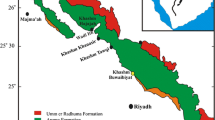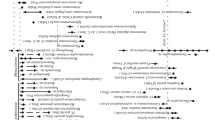Abstract
The stratigraphy of the Farasan Islands (Pliocene–Pleistocene deposits) is established on the basis of a detailed study of six stratigraphic sections described and sampled in the field. Detailed examinations involve the microfacies analyses and identification of macrofossils makes it possible to determine two new informal formations, namely, from the base to the top: Esbah formation of Pliocene age and Farasan formation of Pleistocene age. The detected microfacies types of the studied samples are only carbonate facies and include five major types: mudstone, wackestone, packstone, floatstone and boundstone. No grains of quartz sand or igneous mineral were found in the islands. The nomenclature of the biostratigraphic units established in the present work is not intended to define world-wide zonal standards. It is only used to subdivide the sequence into biostratigraphic zones according to 137 macrofaunal species (78 bivalves, 56 gastropods and three echinoids). These biozones, namely: Lithophaga teres zone (Early Pliocene), Clypeaster reticulates–Laganum depressum zone and Chesapecten madisonius–Noetia limula interval zone are assigned to the Late Pliocene; meanwhile, Noetia limuli–Anadara ovalis interval zone and A. ovalis range zone are assigned to the Pleistocene age. The affinity of the Pliocene–Pleistocene fauna recorded from the Farasan Islands increase with time towards the Indo-Pacific realm. The identified bivalves and gastropods are dominated by the Indo-Pacific forms suggesting the connection of the Red Sea rift with the open Indian Ocean via the Gulf of Aden and Bab El Mandab in the latest Miocene and Early Pliocene.









Similar content being viewed by others
References
Abd El-Wahab M, El-Sorogy AS (2003) Scleractinian corals as pollution indicators, Red Sea coast, Egypt. N Jb Geoll Paläont Abh 11:641–655, Stuttgart
Ahmed SG (1992) Palaeontologic studies on some Neogene sections along the Red Sea Coast, Egypt. Ph.D. thesis, Assiut University. p 249
Ali MSM (1985) On some Pliocene echinoids from the area north of Mersa Alam, Red Sea Coast, Egypt. Palaontologische Zeitschrift 59(3/4):277–300
Beadnell HJL (1924) Report on the geology of the Red Sea Coast between Quseir and Wadi Ranga. Petroleum Research Bulletin 13:1–37
Blackwelder BW (1981) Late Cenozoic Stages and Molluscan Zones of the U.S. Middle Atlantic Coastal Plain. J Paleontol 55:1–33
Bokhari M M A (1981) Eplanatory notes to the reconnaissance geologic map of the Manqaquadrangle, sheet28/34 D, Kingdom of Saudi Arabia. Open File-Report DGMR-Of-01-16. p 32
Cox L R (1929) Notes on the Post-Miocene Ostreide and Pectinidae of the Red Sea region, with remarks on the geological significance of their distribution. Proceeding of the Malacologic Society of London 18. pp 165–209
Cox LR (1931) The geology of Farasan Islands, Gizan and Kamaran Island, Red Sea. Part 2, Molluscan palaeontology. Geological Magazine, LXVII, 1. p. 1–13
Dabbagh A, Hötzl H, Schnier H (1984) Farasan Islands. In: Jado A, Zötl GJ (eds) Quaternary Period in Saudi Arabia Vol. 2. Springer, Wien
Dullo WC, Hotzl H, Jado AR (1983) New stratigraphic results from the Tertiary sequence of the Nidyan area, NW Saudi Arabia. Newsl Stratigr 12(2):75–83, Berlin, Stuttgart
Dunham R J (1962) Classification of carbonate rocks according to depositional texture. In: Ham, W. E. (ed.), classification of carbonate rocks: American Association of Petroleum Geologists Memoir 1. pp 108–121
El-Bedewy FM (1977) Paleontological studies on some Neogene fauna of the area between Quseir and Marsa Alam, Red Sea Coast, Egypt. M.Sc. thesis, Al Azhar University, Cairo. p 200
El-Nahass HA (1997) Biostratigraphy of some Quaternary sequences of the Red Sea coastal plain of Egypt. N Jb Geoll Paläont Abh 205(3):289–321, Stuttgart
El-Sorogy AS (1997) Progressive diagenetic sequence of Pleistocene coral reefs in the area between Quseir and Mersa Alam, Red Sea coast, Egypt. Egypt J Geol 41–1:519–540
El-Sorogy AS (2002) Paleontology and depositional environments of the Pleistocene coral reefs of the Gulf of Suez, Egypt. N Jb Geol Paläont Abh 225(3):337–371, Stuttgart
Embry AF, Klovan JE (1971) A Late Devonian reef tract on Northeastern Banks Island. NWT: Canadian Petroleum Geology Bulletin 19:730–781
Faurot L (1888) Sur les Sediments Quaternaires de 1Ile de Kamarane (Mer Rouge) et du Golfe de Tadjoura. Bull Soc Geol France (3), xvi. pp 528–46
Felesteen A, Khedr E, Abul Magd K (1994) The Neogene-Quaternary sequence of Ras Banas Peninsula: stratigraphicl studies. Egypt J Geol 38(1):267–287
Felix JP (1904) Studien über Tertiäre und Quartäre Korallen und Riffkalk aus Ägypten und der Sinaihalninsel. Zeitschrift der deutschen Geologischen Gesellaschaft 56:168–206, Berlin
Folk RL (1959) Practical petrographic classification of limestones:. AAPG Bull 43:1–38
Gillman M (1968) Primary results of a geological and geophysical reconnaissance of the Jizan coastal plain in Saudi Arabia: AIME regional Tech. Symposium, Rep. 2d, Dhahran. pp 189–208
Grill B, Zuschin M (2001) Modern shallow to deep-water bivalve death assemblages in the Red Sea—ecology and biogeography. Palaeogeogr Palaeoclimatol Palaeocol 168:75–96
Head S M (1987) Introduction. In: Edwards, A. J. & Head, S. M. (eds.): Red Sea. Oxford (Pergamon Press). pp 1–21
Hötzl H, Felber J, Zötl JG (1978a) The Quaternary development of the upper part of Wadi Ar Rimah. In: Al-sayari SS, Zotl JG (eds) Quaternary Period in Saudi Arabia, 1. Springer, New York, pp 173–182
Hötzl H, Kramer F, Maurin V (1978b) Quaternary sediments. In: Al-sayari SS, Zötl JG (eds) Quaternary Period in Saudi Arabia, 1. Springer, New York, pp 264–301
Jado A, Zötl JG (1984) Quaternary Period in Saudi Arabia, 2. Springer, New York, p 361
James NP (1984) Shallowing-upward sequences in carbonates. In: Walker, R.G. (ed) Facies Models: Geological Association of Canada, Geoscience Canada, Reprint Series 1. pp 213–228
Jousseaune F (1888) Description des Mollusques recueillis par M. le Dr. Faurot dans la Rouge le Golfe D 'Aen. Mem. Soc. Zool. France, I. pp 165–223
Kassab AS, Ahmed SG (1994) Miocene Pleistocene macrofossils from the coastal plain between Mersa Alam and Ras Banas, Red Sea, Egypt. Bulletin Faculty of Science, Assiut University, Assiut 23 (1-f). pp 451-485
Kora M, Abdel-Fattah Z (2000) Pliocene and Plio-Pleistocene macrofauna from the Red Sea coastal plain (Egypt): biostratigraphy and biogeography. Geologica et Palaeontologica 34:219–235
Mason JF, Moore QM (1970) Petroleum developments in the Middle East countries in 1969. AAPG Bull 45:1524–1547
MacFadyen WA (1930) The undercutting of coral Reef limestone on the coasts of some islands in the Red Sea. Geogr J 75:27–34, London
MacFadyen WA, Cox LR, Brighoton AG (1930) The geology of the Farasan Islands, Gizan and Kamaran Island, Red Sea. Part 1—General Geology. Geol Mag 68:1–13 (323–333)
Moore RC (1969a) Treatise on Invertebrate Paleontology, Part N. (Mollusca) and Bivalvia, vol 1 and 2. Geological Society of America, Boulder
Moore RC (1969b) Treatise on Invertebrate Paleontology, Part J. (Gastropoda), vol 1 and 2. Geological Society of America, Boulder
Moore RC (1969c) Treatise on Invertebrate Paleontology, Part I. (Mollusca) and Gastropoda, vol 1 & 2. Geological Society of America, Boulder
Murray J (1985) Atlas of invertebrate macrofossils. Longman Group limited in collaboration with the Palaeontological Association. Wiley, London, 241p
Oliver PG (1992) Bivalved seashells of the Red Sea. Christa Hemmen, Wiesbaden. p 320
Plaziat JC, Baltzer F, Choukri A, Conchon O, Freytet P, Orszag-Sperber F, Raguideau A, Reyss JC (1998) Quaternary marine and continental sedimantion in the northern Red Sea and Gulf of Suez (Egyptian coast): influences of rift tectonics, climatic changes and sea-level fluctuations. In: Purser BH, Bosence DWJ (eds) Sedimentation and tectonics in rift basins Red Sea-Gulf of Aden. Chapman & Hall, London, pp 211–222
Purser BH, Bosence DWJ (1998) Sedimentation and tectonics in the rift basin Red Sea-Gulf of Aden. Chapman & Hall, London, p 633
Purser BH, Hötzl H (1988) The sedimentary evolution of the Red Sea rift: a comparison of the northwest (Egyptian) and northeast (Saudi Arabian) margins. Tectonophysics 153:193–208
Purser BH, Philobbos E (1993) The sedimentary expressions of rifting in the NW Red Sea, Egypt. Special Publication 1. Geological Society of Egypt, Cairo. pp 1–46
Ross DA, Schlee J (1973) Shallow structure and geologic development of the southern Red Sea. Geol Soc Amer Bull 84:3827–3848
Ross, D. A. (1974) The Red Sea and the Black Sea. In: Man’s finite earth, part two, oceanography. Burgess Publ Co, Minneapolis. pp 77–88
Sellwood, B. W. (1978) Shallow water carbonate environments. In: Reading, H.G. (ed.) Sedimentary environments and facies. Elsevier, New York. pp 259—313
Sharabati, D. (1984) Red Sea shells. KPI Ltd., London. p 127
Sheppard RC, Sheppard LS (1991) Corals and coral communities of Arabia. Fauna of Saudi Arabia 12:1–170
Skipwith P (1973) The Red Sea and Coastal Plain of the Kingdom of Saudi Arabia. Dir. Gen. Min. Resources. Techn. Rec. 1. Jeddah. p 149
Souaya FJ (1963) Micropaleontology of the sections south of Qoseir, Egypt. Micropaleontology 9(3):233–266
Strasser A, Strohmenger CH, Davaud E, Bach A (1992) Sequential evolution and diagensis of Pleistocene coral reef (South Sinai, Egypt). Sed Geol 78:59–79
Swartz DH, Arden DD Jr (1960) Geologic history of the Red Sea area. Am Assoc Pet Geol Bull 44:1621–1637
Verbinnen G, Dirkx, M. (2005) Red Sea mollusca, part 19. Class: Gastropoda, family: Stomatellide. Gloria Maris 44:1–2 (24–26)
Whittle LG, Kendall CG, Dill RF, Rouch L (1993) Carbonate cement fabrics displayed: a transverse across the margin of the Bahamas platforms near Lee Stocking in the Exuma cays. Mar Geol 110:213–243
Zuschin M, Janssen R, Baal C (2009) Gastropods and their habitats from the northern Red Sea, (Egypt Safaga). In: Part 1: Patellogastropoda, Vetigastropoda and Cycloneritimorpha. Ann Naturhist Mus Wien 111(A):73–158
Zuschin M, Piller WE (1997) Bivalve distribution on coral carpets in the northern bay of Safaga (Red Sea, Egypt) and its relation to environmental parameters. Facies 37:183–194
Author information
Authors and Affiliations
Corresponding author
Rights and permissions
About this article
Cite this article
Khalil, H.M. Pliocene–Pleistocene stratigraphy and macrofauna of the Farasan Islands, South East Red Sea, Saudi Arabia. Arab J Geosci 5, 1223–1245 (2012). https://doi.org/10.1007/s12517-011-0300-0
Received:
Accepted:
Published:
Issue Date:
DOI: https://doi.org/10.1007/s12517-011-0300-0




